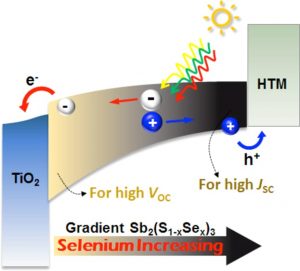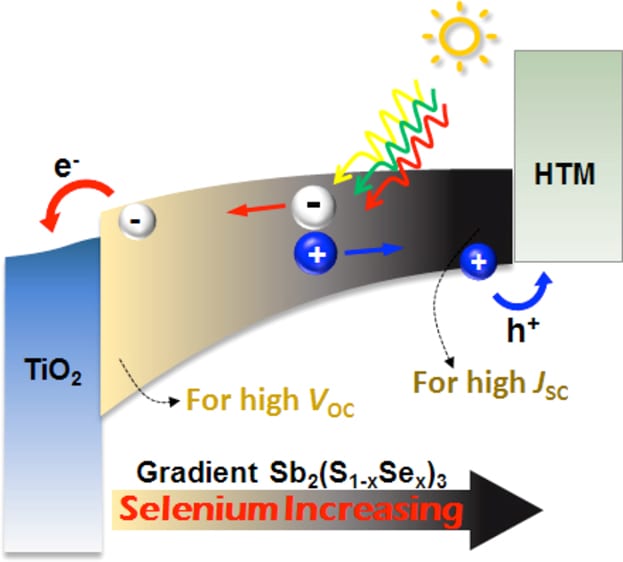Antimony sulfide-selenide (Sb2(S1-x,Sex)3) is a semiconducting material that is earth abundant, has a good long-term stability and low-toxicity, a tunable band gap in 1.1-1.8 eV range, as well as excellent light absorption properties with a maximum efficiency of >30%.
However, boosting its efficiency to a level comparable to that of the established solar technologies, such as thin film and perovskite solar cells, remains a serious challenge. The main reason for that is that on the one hand, the large band gap (~1.8 eV) of Sb2S3 solar cells allows for a high voltage generation, but on the other hand, it unavoidably leads to an insufficient light utilization in the longer wavelength range. Sb2Se3, with a lower band gap of ~1.1 eV, however, is capable of absorbing light towards the near infrared region, but results in a significant voltage loss.
 Since the critical factor that determines the power conversion efficiency of a solar cell is the product between the open-circuit voltage and the short-circuit current density, both of these parameters need to be simultaneously improved.
Since the critical factor that determines the power conversion efficiency of a solar cell is the product between the open-circuit voltage and the short-circuit current density, both of these parameters need to be simultaneously improved.
In a recently published article, in Solar-RRL scientists demonstrate a potential strategy to enhance the power conversion efficiency by employing a composition gradient Sb2(S1-x,Sex)3 as the light absorption material.
In this method, the S-rich Sb2(S1-x,Sex)3 with a large bandgap leads to high voltage output, while the narrow-bandgap selenium-rich Sb2(S1-x,Sex)3 expands the spectral response towards longer wavelengths. Thus, the device yields an open-circuit voltage comparable to Sb2S3 solar cell, resulting in a power conversion efficiency of 5.71% – the highest certified value in planar heterojunction solar cells based on Sb2(S1-x,Sex)3.
This approach offers an effective strategy to the fabrication of composition-graded Sb2(S1-x,Sex)3 for long-term stable solar cells with enhanced performance.

















